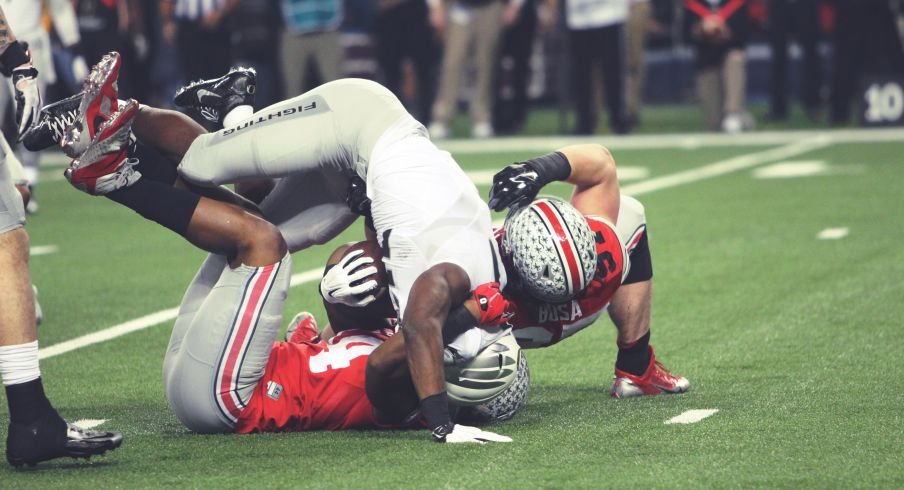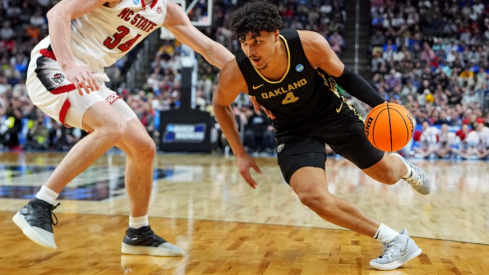The game ended, the confetti fell, the Buckeyes picked up their trophy, everyone who could have gone pro decided to stay and now we’re left with the most satisfying off-season since 2003.
Before we get to National Signing Day, spring football and fall camp, it’s worth examining exactly how this remarkable group of 2014-15 Buckeyes made the magic that resulted in the first ever College Football Playoff National Championship. With a third-string quarterback.
In the simplest terms, it was the owning of third down that made it happen.
| Conversions | Attempts | Pct. | |
|---|---|---|---|
| Regular Season | 85 | 165 | 51.5% |
| College Football Playoffs | 18 | 33 | 54.5% |
Ohio State’s offense was very good at converting third downs into first downs during the regular season. The Buckeyes converted 85 of 165 prior to the Sugar Bowl, which is good for 51.5%. Any team that converts more than half its third downs is going to score a lot of points and win a lot of games, and verily this came to pass—literally, since J.T. Barrett broke Troy Smith’s single-season record for touchdown passes.
Despite a 59-0 pantsing of Wisconsin in the Big Ten Championship, the Buckeyes only converted 2/8 third downs in Indianapolis, for just a 25% success rate. That would not have gotten it done against Alabama or Oregon.
So the offense stepped up its game. The Buckeyes converted 18/33 (54.5%) of their third-down opportunities in the two CFP games. They went 10/18 (55.6%) against Alabama and 8/15 (53.3%) versus the Ducks.
It was a marked improvement over the Wisconsin game and also better than the team did in the previous two games against Michigan and Indiana.
The difference was even more remarkable on defense.
|
Conversions Allowed |
Attempts | Pct. | |
|---|---|---|---|
| Regular Season | 69 | 190 | 36.32% |
| College Football Playoffs | 4 | 25 | 16% |
During the regular season and B1G championship, Ohio State held opponents to 69/190 (36.3%) conversions on third down. The Buckeyes were stingier against Wisconsin, allowing just 5/18 (27.8%) and holding Heisman finalist Melvin Gordon in check.
But after that, the defense got even stronger in the game’s most crucial moments.
Alabama and Oregon combined to convert just 4/25 (16%) of their third-down opportunities. The Crimson Tide offense was only 2/13 (15.4%) on third and Oregon converted just 2/12 (16.7%).
That’s an outstanding work rate, especially when you consider both offenses finished in the top eight in converting third downs this season. Alabama finished fifth (51.26%) and Oregon ended up eighth (49.49%), yet neither found success against Ohio State’s defense.
Credit for this feat goes everywhere. It starts with the defensive line. Joey Bosa, Michael Bennett, Adolphus Washington, Steve Miller and their backups did an outstanding job of preventing run blockers from getting to the second level, and they provided enough pressure on Blake Sims and Marcus Mariota to make them uncomfortable.
The linebackers also stepped up. Darron Lee in particular was all over the field making big plays and preventing small plays by the opposition to turn into explosive ones. Curtis Grant and Joshua Perry filled gaps and prevented scramble yards.
In the secondary, Doran Grant, Eli Apple, Vonn Bell and Tyvis Powell mostly dared receivers to catch short passes and then beat them if they wanted to create big plays. They only allowed a couple of big plays in the two games against two of the nation’s most explosive offenses.
But it doesn’t end with the players. Luke Fickell and Chris Ash created a successful game plan against both teams in the CFP and dialed up the zone blitz of the season, resulting in Miller’s pick six (on a third down) against the Crimson Tide.
Kerry Coombs’ defensive backs played with outstanding technique and tackled well in space. D-line coach Larry Johnson’s group of starters excelled as usual, but his backups also played well, allowing Bosa, Bennett, Washington, and Miller to get important minutes of rest.
By ruling third down, Ohio State completely took control of both playoff games. Mistakes by the offense—turnovers in both games and settling for red zone field goals in the Sugar Bowl—were the only thing that prevented a pair of blowouts.
A 3 percentage point increase in third-down efficiency from an already potent offense and an incredible 20 percentage point improvement in defensive stops on the all-important down are the reason why the Buckeyes hoisted the trophy on Monday night in Dallas.


